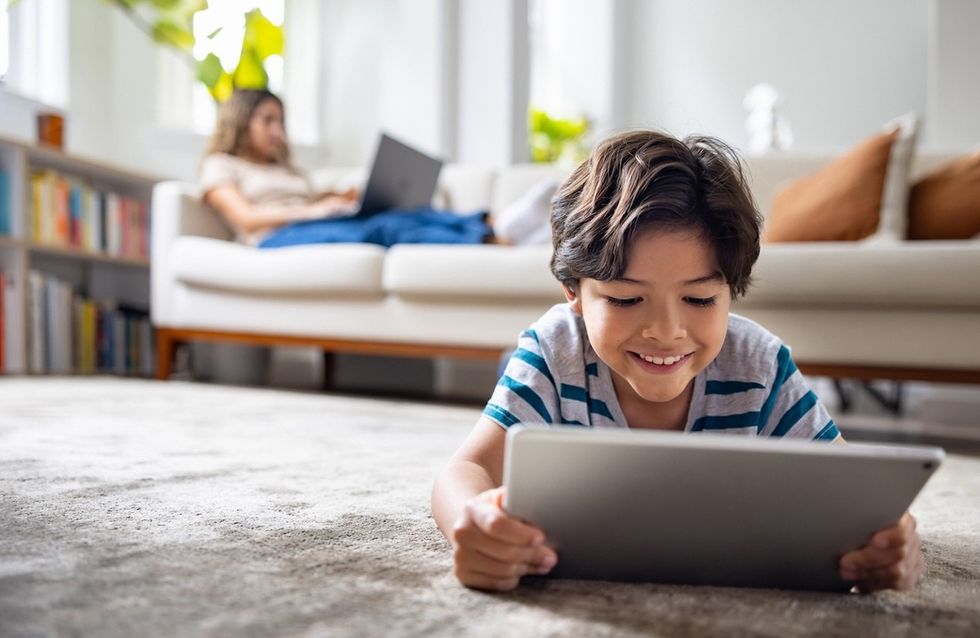Compared with generations of parents past, today’s moms and dads are overworked and overwhelmed. It’s not that the challenges of parenting are new, of course—those are as old as humanity. The difference is that today, the expectation to provide round-the-clock attention to our kids has skyrocketed to new heights. As a result, caregivers are desperate for relief as they toggle between demanding jobs and equally demanding lives at home.
For many parents, that’s where screen time comes into play—though you might not know it from talking to them. That’s because, according to a new survey conducted by the play learning app Lingokids, nearly one-third of parents of children aged two to eight admit to lying about how much screen time they allow.
RELATED: 5 Signs You Have Toxic Parents, According to Therapists.
The sense of anxiety behind this common omission will feel familiar to most parents, says Cristobal Viedma, CEO and founder of Lingokids. In fact, he notes that 74 percent of parents report feeling guilty about how much time their kids spend on screens, while 77 percent say they’ve felt judged by others for those same choices.
“The truth is, this whole digital parenting thing? It’s still pretty new. There’s no instruction manual,” Viedma tells Best Life. “Sure, screens can open up amazing opportunities for learning and development—way beyond the old-school TV shows we had. But they also bring a lot of unknowns: Is this content actually helping? Is it age-appropriate? Are my kids using their time in a healthy way?”
He adds that for many parents, this feeling of disorientation comes with “a big, heavy feeling: screen time guilt.”
This concept of guilt has guided the company’s powerful new ad campaign, which has already garnered nearly eight million views on YouTube in the week since its release. The unscripted commercial quite literally puts real-life parents on trial, inviting them into a courtroom to share their stories and decide once and for all whether their guilt about screen time is founded. Several parents broke down in tears on the stand as the judge ruled them guilty—but only of being too hard on themselves.
The message appeared to resonate in the comments section, where everyday parents contributed their own testimonials. “This video nails a modern moral dilemma and its deep emotional stakes for parents, kids, and society,” one viewer wrote.
Mona Amin, DO, a pediatrician who goes by the name Dr. Mona on her popular social media brand, @PedsDocTalk, agrees that it’s time to reframe the conversation around screen time for kids. Though she recommends a more broadly restrictive approach for children under the age of five and even more so under the age of two, she says that most parents of elementary-aged children would benefit from taking a more nuanced approach.
“I think we’ve been stuck in an all-or-nothing mindset: either we shame ourselves for letting our kids use screens at all, or we throw up our hands and say, ‘It’s just part of modern life,'” the doctor tells Best Life. “But the reality is—it’s not about how much screen time you allow. It’s about how it’s used, what it’s replacing, and whether it aligns with a child’s developmental needs.”
Instead of asking, “Is this too much?” Dr. Mona encourages parents to ask, “Is this helping or hindering?”
“Is it calming, educational, and used with intention? Or is it replacing sleep, movement, play, and connection?” she muses. “One of the biggest red flags I see is mindless, passive viewing in children—especially on handheld devices. Screens replacing emotional regulation—like using YouTube to stop a tantrum—or screen time that cuts into sleep, family connection, or physical activity” are also best eliminated.
RELATED: 10 Ways to Save Money on Childcare, According to Financial Experts.
Asked for her best screen time tips, Dr. Mona shared six key ways to help establish healthy habits:
- No screens under one except for video chatting family. 1-2 co-watching on a large television. 2-5 limit iPad use for eye health or for educational apps for 20 minutes at a time. After 5, family rules that make sense.
- Watch with your child when possible. Co-viewing helps kids understand, ask questions, and learn to reflect.
- Set boundaries with love and logic. Predictable routines and limits around screen use help kids feel secure, not punished.
- Narrate your own use. If you’re working or texting, say it aloud: “I’m answering a message, and then I’m all yours.” It helps children feel seen and models healthy tech use.
- Protect the basics. Make sure screens aren’t replacing movement, sleep, eye contact, or time outdoors.
- Prevent eye strain. Encourage breaks using the 20-20-20 rule: every 20 minutes, look at something 20 feet away for 20 seconds. Dim lighting, large screens over small ones, and sitting back from the screen can also help.
“And remember,” the pediatrician says, “this isn’t about perfection. It’s about protection. Protecting connection, development, and curiosity. We spend so much energy counting minutes, setting timers, and tracking apps—but the truth is, your connection with your child will always matter more than any algorithm or screen rule.”
Dr. Mona adds that kids don’t need perfect parents, available 24 hours a day. They need “attuned ones,” who make the most of their time together when possible.
“Kids need to feel seen, heard, and prioritized—not just when we put their screen down, but when we put ours down too,” she says.
Content shared from bestlifeonline.com.

